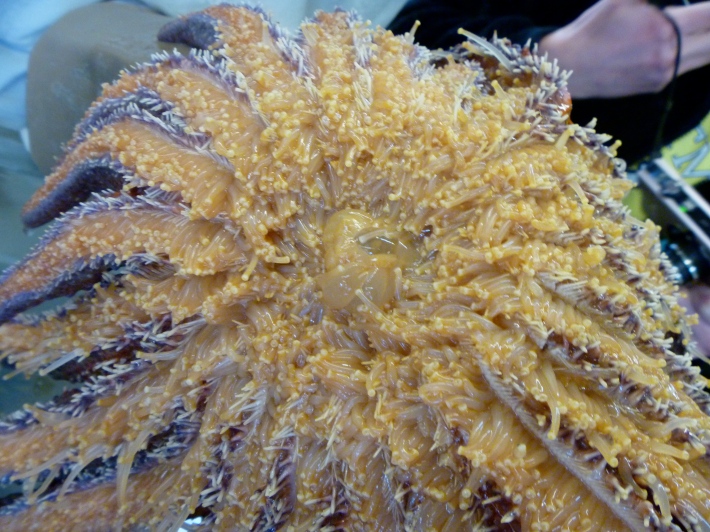It’s a good question, and it merits a good answer. I didn’t have one yesterday when this was posed to me, but now I do. It’s right here, on the back:
But fear not, I’m not just going to talk about sea star butts. That would be silly and we are all business here at the Daily Science. SUCH BUSINESS.
So! Sea stars belong to the phylum echinodermata, along with sea cucumbers and sea urchins. Despite their widely varying appearances, echinoderms share several common characteristics, including a distinct body cavity (allows for organ systems with different functions to remain separate, also called a coelom), radial symmetry as adults, a water vascular system (no blood, just water circulating the body) and tube feet. Tube feet are those little elastic nubbins you seen on the bottom of the sea star. They have incredible gripping power, to the point where they pop off if you even gently pry a sea star off a rock. Not to fear, though! The tube feet grow back easily and the sea stars are used to that sort of thing. By that I mean that sea stars have a funny habit of sacrificing their own limbs when endanger. So rather than let themselves die, they’ll drop an arm and limp for the hills. Here’s where radial symmetry comes in hand; any glands or organs present in one arm are present in all arms. Which is great cause nothing sucks more than escaping a predator and realizing you left your digestive glands with the hungry manta ray. Awkward.
Although sea stars have self-evisceration down pat, eating is…well, it’s an ordeal. Rather than crunch, rasp or clobber their armored prey, sea stars dissolve it. Not like with pre-digesting necrotizing venom. That would be too cool for sea stars. Nope, they grab their prey and rub it with their stomach. I don’t mean their ventral (belly) surface, I mean THEY EJECT THEIR STOMACH AT THEIR FOOD AND DISSOLVE IT. Sea stars can’t even wait to get the mussels inside their bodies before digesting it! I mean really, so impatient. Honestly, it’s a nifty adaptation to armored prey in an animal that must also remain soft and elastic (to withstand wave shock). Still doesn’t stop sea stars from being freaky as hell.
Hope I have satisfied all your burning curiosities about sea star butts and how they eat. Now I’m going to go throw my guts at something. Not literally though, thank GOD.
PS. If you’re from the Pacific Northwest and enjoy tidepooling, be on the lookout for six-armed sea stars! Five-armed pichnopodia and however-the-hell-many armed pisaster (sun stars) are very common and like most sea stars will release their young into the cold cruel sea world to fend for themselves. Six-armed stars on the other…arm, actually brood over and protect their larvae for a while to increase their chances of survival when they do become independent. But after that, no more allowance or drives to the mall to hang with their friends. Those kids are losers anyway.
Sources
-. 2010. GRE Subject Test: Biology 5th Ed. Kaplan, New York.
Yancey, Paul. “Biotic Interactions—Feeding Adaptations.” Marine Biology. Whitman College. Walla Walla, WA. 5 4 2011. Lecture.

